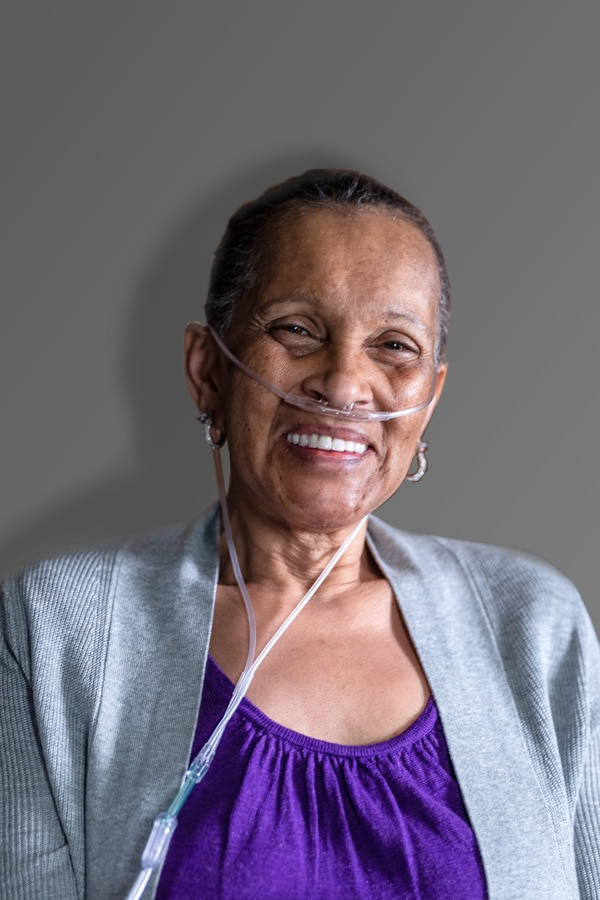Smoking and COPD
Chronic obstructive pulmonary disease (COPD) refers to a group of diseases that cause airflow blockage and breathing-related problems. COPD includes emphysema and chronic bronchitis.1
With COPD, less air flows through the airways—the tubes that carry air in and out of your lungs—because of one or more of the following:2
- The airways and tiny air sacs in the lungs lose their ability to stretch and shrink back.
- The walls between many of the air sacs are destroyed.
- The walls of the airways become thick and inflamed (irritated and swollen).
- The airways make more mucus than usual, which can clog them and block airflow.
In the early stages of COPD, there may be no symptoms, or you may only have mild symptoms. As COPD worsens, the symptoms may become more severe. Symptoms of COPD include:2
- A cough that lingers for a long time and doesn’t go away completely, or a cough that produces a lot of mucus
- Shortness of breath, especially with physical activity
- Wheezing (a whistling sound when you breathe)
- Tightness in the chest
Not everyone with these symptoms has COPD. A doctor can determine if you have COPD or another condition that has similar symptoms.
How severe your COPD symptoms are depends on how much lung damage you have. If you continue smoking, the damage will occur faster than if you stop smoking.2
COPD is usually caused by cigarette smoking, though long-term exposure to other lung irritants, like secondhand smoke, can also contribute to COPD.2,3 As many as 1 out of 4 Americans with COPD never smoked cigarettes.4 However, smoking accounts for as many as 8 out of 10 COPD-related deaths3 and 38% of the nearly 16 million U.S. adults diagnosed with COPD report current smoking.5
Smoking and secondhand smoke exposure during childhood and teenage years can slow lung growth and development. This can increase the risk of developing COPD in adulthood.3,6
The best way to prevent COPD is to never start smoking, and if you do smoke, to quit.6 Talk with your doctor or other health care professional about resources that can help you quit, like counseling and medication. Also, stay away from secondhand smoke, which is smoke from burning tobacco products, such as cigarettes, cigars, hookah, or pipes.3,7 Secondhand smoke also is smoke that has been exhaled, or breathed out, by a person smoking, or that comes from the end of a lit tobacco product.2,7
COPD treatment can alleviate symptoms, decrease the frequency and severity of exacerbations, and increase exercise tolerance. Treatment options that your physician may consider include:1
- Quit smoking. For people who smoke, the most important part of treatment is smoking cessation.
- Avoid tobacco smoke and other air pollutants at home and at work.
- Ask your doctor about pulmonary rehabilitation8, which is a personalized treatment program that teaches COPD management strategies to improve quality of life. Programs may include plans that teach people how to breathe better and conserve their energy, as well as provide advice on food and exercise.
- Take medication. Symptoms such as coughing or wheezing can be treated with medication.
- Avoid lung infections. Lung infections can cause serious problems in people with COPD. Certain vaccines, such as flu and pneumococcal vaccines, are especially important for people with COPD. Learn more about vaccination recommendations. Respiratory infections should be treated with antibiotics, if appropriate.
- Use supplemental oxygen. Some people may need to use a portable oxygen tank if their blood oxygen levels are low.
- 1-800-QUIT-NOW
- 1-855-DÉJELO-YA (Español)
- 1-800-838-8917 (中文)
- 1-800-556-5564 (한국어)
- 1-800-778-8440 (Tiếng Việt)
- Text QUITNOW to 333888—Message and data rates may apply
- quitSTART appexternal icon
- Quit Smoking (En Español)
- Smokefree.govexternal icon (En Español)
- Asian Smokers’ Quitlineexternal icon
The following resources provide information and support to people with COPD and their caregivers:
- To learn more about COPD, visit the National Heart, Lung, and Blood Institute’s COPD Learn More Breathe Better web page.
- To find peer support, an online community, and events in your area, visit the COPD Foundation website and 360Social.
- To join a network of patients affected by COPD, visit the COPD Patient-Powered Research Network, which is a lung health research registry.
- Centers for Disease Control and Prevention. Basics About COPD [last reviewed 2021 June 9; accessed 2022 Feb 7].
- U.S. Department of Health and Human Services, National Institutes of Health, National Heart, Lung, and Blood Institute. COPD [accessed 2022 Feb 7].
- U.S. Department of Health and Human Services. The Health Consequences of Smoking—50 Years of Progress: A Report of the Surgeon General. Atlanta: U.S. Department of Health and Human Services, Centers for Disease Control and Prevention, National Center for Chronic Disease Prevention and Health Promotion, Office on Smoking and Health, 2014 [accessed 2022 Feb 7].
- Centers for Disease Control and Prevention. Chronic Obstructive Pulmonary Disease and Smoking Status — United States, 2017. MMWR Morb Mortal Wkly Rep June 21, 2019 [accessed 2022 Feb 7].
- Wheaton AG, Cunningham TJ, Ford ES, Croft JB. Employment and Activity Limitations Among Adults with Chronic Obstructive Pulmonary Disease — United States, 2013. MMWR Morb Mortal Wkly Rep. March 27, 2015:64 (11):290–295 [accessed 2022 Feb 7].
- U.S. Department of Health and Human Services. A Report of the Surgeon General. Preventing Tobacco Use Among Youth and Young Adults: We CAN Make the Next Generation Tobacco-Free. Atlanta: U.S. Department of Health and Human Services, Centers for Disease Control and Prevention, National Center for Chronic Disease Prevention and Health Promotion, Office on Smoking and Health, 2012 [accessed 2022 Feb 7].
- National Toxicology Program. Report on Carcinogens, Tobacco-Related Exposures, Fourteenth Edition [PDF – 311KB]. Research Triangle Park (NC): U.S. Department of Health and Human Services, Public Health Service, 2016 [accessed 2022 Feb 7].
- U.S. Department of Health and Human Services, National Institutes of Health, National Heart, Lung, and Blood Institute. Pulmonary Rehabilitation. [accessed 2022 Feb 7].


